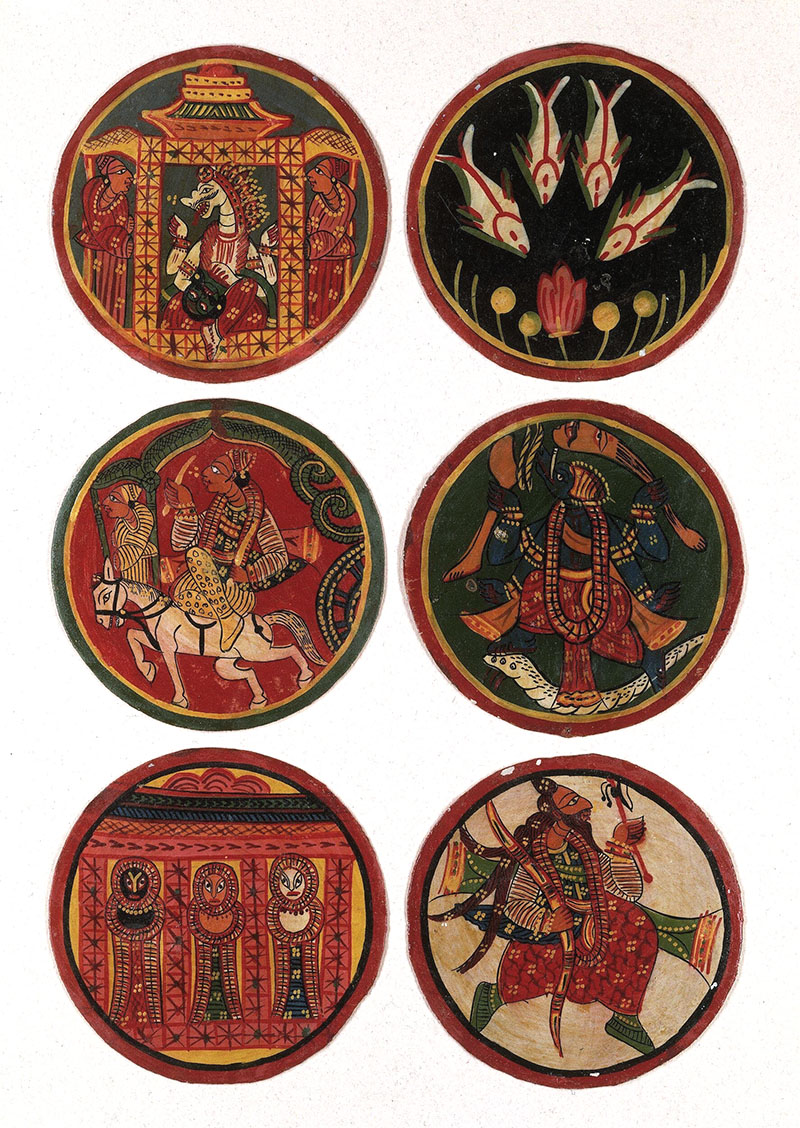ARTICLE
Dashavatara Ganjifa
The ten suits follow the order of Vishnu’s incarnations as they appear in Hindu mythology. The first suit is Matsya, which typically depicts a blue, four-armed Vishnu emerging from a fish’s mouth. The suit sign is also a fish.
The second suit is Kurma, whose king card shows a blue figure rising from a turtle’s mouth and, in some more elaborate examples, against a backdrop of the churning ocean. The suit sign is a turtle.
The third suit is Varaha, where the king is a blue, four-armed figure with a boar’s head, and the suit sign is a boar or a conch.
The fourth suit is Narasimha, with the king depicted as a human figure with a lion’s head, seated on a throne with Hiranyakashyap’s slain body over his lap, and Lakshmi and Prahlada by his side. The suit sign is either a lion or chakram (a circular metal weapon typically worn around a turban).
The fifth suit is Vamana, whose king is shown as a diminutive man holding an umbrella and a kamandalu, a metal pot for carrying and pouring water. These items, which are suggestive of a Brahmin begging for alms, are also used as the suit signs.
The sixth suit is Parashurama, whose king card shows this incarnation in battle with Kartavirya and whose suit sign is an axe.
The seventh sign is Ram, whose king card depicts Ram either fighting Ravana in Lanka, or seated on a throne beside Sita. The suit sign is Ram’s bow and arrow in most decks, but in the decks that were used at court, the suit sign is monkeys.
The eighth and ninth suits may feature Balaram, Krishna, the Buddha or Jagannath, depending on the region. Krishna – who is treated as an independent deity in Rajasthan, Nepal and the northern Deccan – is not included among the suits of Dashavatara Ganjifa in these areas, although in other contexts Krishna replaces Balarama as a more important figure. Jagannath appears as the ninth suit in West Bengal and Odisha due to his large following in that region. The Buddha, who is considered an incarnation of Vishnu only within the Puranas, is less frequently found among Dashavatara Ganjifa decks. When he is included, however, he is typically the ninth suit. The suit signs are the plough for Balaram, the cow or a human face ornamented with a feather for Krishna, and lotuses for Jagnnath. The Buddha suit is also represented by lotuses or a human head wearing a crown.
The tenth and final suit is Kalki, in which Vishnu is depicted as a human man riding a winged white horse.
While the deck described above represents the most common form of the Dashavatara Ganjifa, individual and regional variations sometimes included more incarnations of Vishnu and, therefore, more suits. A notable example of this are the surviving cards of a deck with thirty two suits, now housed at the Deutsches Spielkartenmuseum in Leinfelden-Echterdingen, Germany. More recent packs – largely from Sawantwadi and Odisha, and made in the late twentieth and early twenty-first centuries – are part of the collection at the Indira Gandhi National Centre for the Arts. Dashavatara Ganjifa cards were the basis of an installation by the artist duo Thukral & Tagra, titled Walk of Life, during their exhibition Games People Play (2015) at the Dr. Bhau Daji Lad Museum.
Bibliography
Our website is currently undergoing maintenance and re-design, due to which we have had to take down some of our bibliographies. While these will be re-published shortly, you can request references for specific articles by writing to hellomapacademy@map-india.org.







